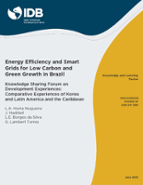Energy Efficiency and Smart Grids for Low Carbon and Green Growth in Brazil: Knowledge Sharing Forum on Development Experiences: Comparative Experiences of Korea and Latin America and the Caribbean
Date
Jun 2015
The Brazilian continental dimensions and diversified natural resources are proportional to the challenges to develop its infrastructure sustainably and supply proper public services to more than 200 million inhabitants. Energy consumption has doubled since 1990, fostered by economic growth and the expansion of middle class. In this context, promote energy efficiency, in a broad sense, is urgent and rational. Brazil has a relatively long history in promoting energy efficiency at final user level. A landmark of this process is the Brazilian Labeling Program, launched in 1984, as direct consequence of high prices of energy at that time. This program was coordinated by the National Institute of Metrology, Standardization and Industrial Quality, which sets standards for evaluation, ranks the performance of energy equipment and imposes a classificatory labeling to inform consumers, with a label similar to other countries. The National Electricity Conservation Program was created in 1985 by MME and is executed by ELETROBRÁS. The energy saving induced by this program in 2013 is equivalent to 2.1% of the total electric energy consumption in the period, corresponding to the annual energy consumption of about 5 million Brazilian households. In 2001, Federal Law 10,295, also known as the Energy Efficiency Law, was approved to reinforce those energy efficiency programs, allowing the Brazilian government to establish Minimum Energy Performance Standards for appliances and energy equipment, prohibiting the commercialization of low efficiency models and promoting the progressive withdrawal of low-efficiency models. According to the National Energy Plan 2030, up to 15.5 GW of electricity generation could be saved as a result of energy efficiency in the next 20 years.
The Smart Grids, adopting modern technologies in electricity distribution has been proposed in Brazil improve the quality provided in the low voltage service, reduce losses, and reduce operating costs, among others. Several regulations related to this subject, dealing with grid connection for distributed small-scale generation, the establishment of the 'hourly tariff', with the regulation of the use of PLC; and with the compulsory use of Geographic Information System. Currently, dozens pilot projects on Smart Grids are underway in the country. Two projects are presented in detail: CEMIG and AES Eletropaulo, two Brazilian power utilities.
The Smart Grids, adopting modern technologies in electricity distribution has been proposed in Brazil improve the quality provided in the low voltage service, reduce losses, and reduce operating costs, among others. Several regulations related to this subject, dealing with grid connection for distributed small-scale generation, the establishment of the 'hourly tariff', with the regulation of the use of PLC; and with the compulsory use of Geographic Information System. Currently, dozens pilot projects on Smart Grids are underway in the country. Two projects are presented in detail: CEMIG and AES Eletropaulo, two Brazilian power utilities.



